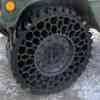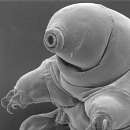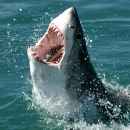Inventions and Discoveries
Many new inventions and discoveries come from imitating nature, which is known as biomimicry from bios meaning life, and mimesis meaning to imitate.
 Studying how nature has perfected models to achieve specific results, enables us mimic those models to get similar results with the products we develop.
Studying how nature has perfected models to achieve specific results, enables us mimic those models to get similar results with the products we develop.
For example, this airless tire mimics the geometric design of a honeycomb in order to achieve flexibility and strength in a tire that doesn't contain air.
Similarly, the invention of velcro was modeled from the barbs on the burrs of the burdock plant. Below are some interesting discoveries that scientists hope will lead to new inventions.
Water Bear
If there was life on other planets what would it look like? If extraterrestrials travel the universe, how could humans do the same?
 Astrobiologists
at the Nasa Ames Research Center
are struggling to answer these
kinds of questions.
Astrobiologists
at the Nasa Ames Research Center
are struggling to answer these
kinds of questions.
It would appear to be more science fiction than science but Dr. Daiki Horikawa has taken a unique approach in his research at Nasa.
He is studying a creature on our planet that is more alien than it is earthly.
This creature is short and chubby. It has eight legs with claws. It can survive in extreme habitats that would kill most life on earth.
This microscopic animal can survive temperatures as high as 151 °C (304 °F) or as low as −200 °C (-328 °F).
It can survive in a vacuum and can withstand pressures of 6,000 atmospheres, which is six times greater than the pressure at the bottom of our deepest ocean trench.
It can live ten years without food or water, and withstand radiation a hundred times greater than the lethal dose for humans.
This life-form is called a tardigrade, meaning slow walker. It's original name is tardigrade kleiner wasserbär, meaning water bear because it walks like a bear. Adults range in size from 0.1mm to 1.5mm (0.059 in).
Researchers have discovered that tardigrades go into a type of suspended animation when confronted with extreme environmental conditions. During this dormant state, all functions cease to exist until conditions improve. They can dehydrate their bodies from 85% water to just 3% to avoid being torn apart by freezing.
It's like they temporarily die because their dormancy defies the definitions for being alive. Basically, they die and then revive themselves.
 Nasa put tardigardes outside an
orbiting space shuttle
exposing them to extreme temperatures
ranging 248 degrees F (120 degrees C) to
-148 F ( -100 C), as well as excessive doses
of radiation and the hard
vacuum of space.
Nasa put tardigardes outside an
orbiting space shuttle
exposing them to extreme temperatures
ranging 248 degrees F (120 degrees C) to
-148 F ( -100 C), as well as excessive doses
of radiation and the hard
vacuum of space.
After ten days the tardigardes were retrieved from space. Amazingly, they revived themselves to full health. Some of them even laid eggs that bore healthy offspring.
In his research, Dr. Horikawa has discovered one of the tardigardes secrets. They have an unusual ability to repair critically damaged DNA.
Learning how tardigardes repair themselves could result in new inventions and discoveries that would enable humans to endure the rigors of space travel.
Sources: astrobiology.nasa.gov; creativecommons.org
Owl Feathers
Owls can fly in complete silence, swooping quietly down on their prey. It is an advantage owls have over other predatory birds such as eagles and hawks that rely on speed to hunt.
 Research by a team of scientists, lead
by Justin Jaworski of Lehigh University, has discovered
unique characteristics in owl feathers
that may explain their silent flight.
Research by a team of scientists, lead
by Justin Jaworski of Lehigh University, has discovered
unique characteristics in owl feathers
that may explain their silent flight.
Owls have developed a specialized velvet-like surface on their wing feathers.
This velvet down has a sophisticated forest-like geometry that absorbs noise caused by movement of the wings. "It looks like vertical strings with interlocking barbs at their tops," explains Jaworksi.
The interlocking barbs create a canopy over the wing surface and the space between acts as a noise suppressant.
William Devenport, professor of aerospace and ocean engineering at Virginia Tech is working with Jaworski to develop technology that will imitate the velvet surface of owl feathers.
They're optimistic their work will result in new inventions and discoveries that will have far-reaching implications for wind turbines, aircraft and submarines.
Sources: lehigh.edu/news; creativecommons.org
Shark Skin
Scientists have speculated
that the shape and
positioning of
these denticles could reduce
resistance and turbulance as a
shark moves through the water.
But there wasn't
any way to test this theory because
the complexity of shark skin couldn't
be replicated - until recently. Scientists at Harvard University
used
3D printing technology to
create
synthetic
denticles from a
detailed scan of shark skin. The artificial denticles were
attached to a flexible pad
and used in a water tank to
simulate how sharks swim. High definition slow motion
photography was then used to record the
experiments, which revealed for
the first time a unique
characteristic about shark
skin.
"Millions of years of evolution give us solutions
to problems that we may not have thought of," says Lauder, lead researcher on the shark skin project. "It pays us to understand how the natural world works," he says. Their shark skin research could lead to new inventions and discoveries that
would
revolutionize the
airline, automobile
and shipbuilding industries.
Sources: news.harvard.edu; creativecommons.org
 Sharks have evolved and perfected a skin structure that helps them swim fast and quiet. Instead of scales, sharks are covered
with microscopic teeth known as dermal denticles,
which means tooth-like skin.
Sharks have evolved and perfected a skin structure that helps them swim fast and quiet. Instead of scales, sharks are covered
with microscopic teeth known as dermal denticles,
which means tooth-like skin. When water moves over
a denticle it creates
a leading-edge vortex
(a tornado) that sucks the
shark forward. This thrust-enhancing
design was discovered to
increase speed by
6.6% and energy
efficiency by 5.9%.
When water moves over
a denticle it creates
a leading-edge vortex
(a tornado) that sucks the
shark forward. This thrust-enhancing
design was discovered to
increase speed by
6.6% and energy
efficiency by 5.9%.


